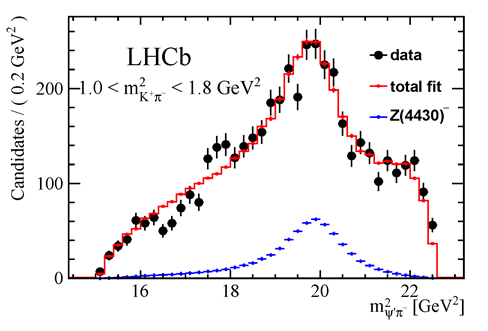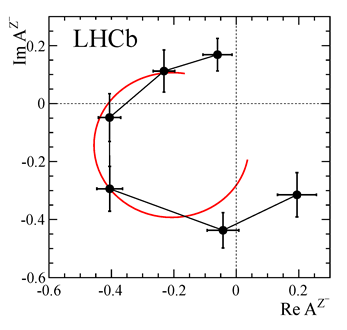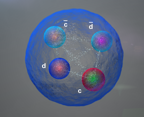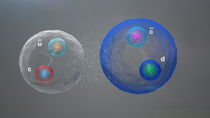The LHCb Collaboration has published yesterday results of precise measurements of properties of the Z(4430)– particle which allow to determine unambiguously its exotic nature. In the traditional quark model, the strongly interacting particles (hadrons) are formed either from quark-antiquark pairs (mesons) or three quarks (baryons). Particle physicists were searching since 50 years for the particles, called exotic hadrons, which could not be classified within this scheme. Many candidates have been proposed but up to now there has not been unambiguous proof of their existence.
The first evidence for the Z(4430) particle has been presented in 2008 by the Belle Collaboration as narrow peak in the ψ’π– mass distribution in the B → ψ’Kπ– decays. In the latest Belle publication the observation of the Z(4430) particle is confirmed with a significance of 5.2σ and a 3.4σ evidence is presented that the quantum numbers JP = 1+ are favored over the other spin assignments. There are many so called charmonium cc neutral states in this mass region. The fact that the Z(4430) is a charged particle does not allow to classify it as a charmonium state making this particle an excellent exotic candidate. The BaBar collaboration could explain the Z(4430) enhancement in their data by a possible feature of experimental analysis (so called reflections, for experts), not contradicting in the same time the Belle evidence.
The LHCb Collaboration has reported yesterday an analysis of about 25 200 B0 → ψ’Kπ–, ψ’ → μ+μ– decays observed in 3 fb−1 of pp-collision data collected at √s = 7 and 8 TeV. The LHCb data sample exceeds by an order of magnitude that of Belle and BaBar together. The significance of the Z(4430)– signal is overwhelming, at least 13.9σ, confirming the existence of this state. The Z(4430)– quantum numbers are determined to be JP = 1+ by ruling out 0–, 1–, 2+ and 2– assignments at more than 9.7σ, confirming the evidence from Belle. The LHCb analysis establishes the, so called, resonant nature of the observed structure in the data, and in this way proving unambiguously that the Z(4430) is really a particle.
The minimal quark content of the Z(4430) state is ccdu. It is therefore a four quark state or a two-quark plus two-antiquark state.
click the images for higher resolution
The black points at the left image above show the ψ’π– invariant mass squared distribution of the data. The blue histogram shows the Z(4430) contribution. The right image shows the so called Argand diagram proving to the experts that the Z(4430) structure seen in the data (black points) represents really the resonant particle production and decay, since it follows approximately a circular path (red circle).
Read more in the LHCb publication here, in the CERN Quantum Diaries in English and French, in the CERN Courier article and also in the “Quarks bonding differently at LHCb” blog. See special video at CERN CDS or YouTube and the Z(4430) for saxophone quartet.
“A model-independent confirmation of the Z(4430)– state” was submitted for publication in October 2015. A possibility of explaning the Z(4430) enhancement by the so called reflection of Kπ resonances, proposed by the BaBar collaboration, is excluded with a significance exceeding 8σ. Experts are invited to see the Fig. 9 and 12a and read the details in the paper.
Added in October 2016: Scientists will try to understand the “internal mechanism” of quark interactions inside tetraquarks. The two possibilities are illustrated in the figure. The color of the central part of each quark is related to the strong interaction color charge, while the external part shows its electric charge. The quarks could be tightly bound, or they could also be loosely bound in meson-meson molecule, in which color-neutral mesons feel a residual strong force similar to the one that binds nucleons together within nuclei. It is hoped that future measurements by LHCb will help to answer this question.




